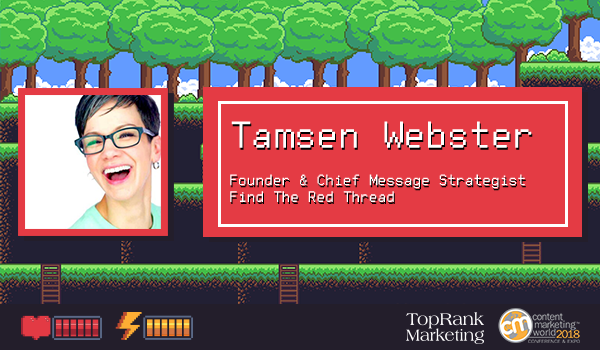
Few things are more inspiring than the before-and-after weight loss photo: two drastically different figures juxtaposed against one another, usually connected by an impossibly short span of time.
It’s not just the physical transformation that is striking in these portrayals. Even more so, it’s the mental transformation. Something clicked in that person’s head, causing them to fully commit and make the difficult changes necessary to turn their goals into reality. Then, they did it.
Branding expert Tamsen Webster saw this dynamic play out, in various forms, time and time again during her many years as a leader in the Weight Watchers organization. And it’s a big part of what drove her to create Red Thread, a messaging framework focused on tapping into those deep, uniquely human motivations that spark action (or, as she puts it, make inaction impossible).
At Content Marketing World in September, Tamsen will speak about How to Make Your Ideas Irresistible. In anticipation of her session, we chatted with her about uncovering shared values with your audience, eliminating “one-size-fits-most” messaging, and aiming to change perspectives rather than beliefs.
What does your role as Founder and Chief Messaging Strategist at Find the Red Thread entail? What are your main areas of focus and key priorities?
Well, the nice thing about being a solo practice is that it means what I need it to mean at the time! My days are spent in a mix of work with clients, business development, and product/content development – I go where my energy, inspiration, and needs take me.
How would you succinctly describe the “Red Thread Method” and why it makes sense for today’s content marketers?
We can’t change what people do until we change how they see. The Red Thread Method helps you uncover that link for a particular audience and business goal so you can build content and messaging around it.
What did your experience as a Weight Watchers leader teach you about the fundamentals of creating irresistible messaging?
Pretty much everything. I know that sounds like a joke, but it’s not. Week in, week out at Weight Watchers, I saw what did and didn’t move people to make changes – what kinds of information they needed, and in what combination. When I took those lessons and looked at the marketing around me (including marketing I had helped produce!), I realized how often we focused on what we wanted people to do differently more than what they needed to hear to see the differently. Once I started switching my marketing to match the framework of messaging I built for myself at Weight Watchers, lo and behold, I became a much more effective marketer.
How can marketers stop seeing change as a barrier and start seeing it as an opportunity? What’s required to drive this shift in mindset?
That all depends on why they see change as a barrier in the first place. The only thing that will shift that mindset is understanding how it puts both something marketers want and something they believe is in jeopardy. For example, if a marketer wants to be seen as an expert in social channels, they likely see change in those areas as something to be overcome – the constantly shifting landscape makes it impossible to expert in all things all the time. If they also believe, however, that “the only constant is change,” making inaction impossible: they’ll either need to change their goal, their attitude toward change, or how they go about being seen as an expert. The key is always in finding that combination of wants and beliefs that makes inaction impossible.
Some find it counterintuitive that in order to increase your reach and impact, you need to narrow your message. Why is this important in today’s environment?
It’s all about fit for the message. Think about the last time you bought something that was “one size fits all.” Did it fit? Probably yes – you could get into it. Depending on your size it was cavernous, achingly tight, or in the category of “this’ll do.” But did fit like it was yours? Could you identify it blindfolded? Of course not. Now imagine you’ve had something tailored to fit you – like a jacket or a pair of pants. Done well, it should fit like a glove. If you put it on, you’d know instantly that it belonged to you.
Messages operate the same way. We way we want customers to feel a part of the brand. We want them to feel like the brand belongs to them. But then too often we send out “one size fits most” messages… and wonder why we don’t get that sense of belonging that’s a hallmark of great brands.
Your brand is not for everyone. It isn’t. It’s for the people who want something you can help them get, who value the same things you do, and who see the world the same way you do. And that’s not everyone. Full stop.
How do the tenets of giving great presentations and speaking sessions apply to the bigger picture of content marketing?
Any truly great presentation doesn’t just inform and inspire… it implants a new way of seeing. It gives you something that you can’t unhear. Something that creates a permanent shift in thinking, and thus in behavior. Most content marketing doesn’t need to inspire (at least not in the go-climb-a-mountain or be-your-best-self sense), but it does need to create that same shift.
I’ll say it again: you can’t change what people do until you change how they see. There’s no better example than TED Talks that a very short piece of content can do just that. (The longest TED Talks are only about 2500 words – not long!) The more content marketers can adopt those lessons from great talks, the more powerful their messages will be, no matter the subject.
But hear me on this: those lessons aren’t just the surface things like “give it an SEO-friendly title” or “tell a personal story.” Both of those techniques can be helpful.
But the lessons marketers really need to learn are around where the greatest levers in messaging are. And here’s what’s counterintuitive: the most powerful levers at our disposal are the ones that don’t move – people’s wants and beliefs. Yet so much of marketing focuses on trying to get people to want something they don’t actively want or believe something they don’t currently believe. The only things we’re likely to change in the short term are perspectives. And that’s what great talks – and great content in any form – do.
Looking back, is there a particular moment or juncture in your career that you view as transformative? What takeaways could other marketers learn and apply?
It started with a mystery. See, I spent the first 15 years or so of my marketing career working in and with nonprofits. Here in Boston, where I live, those nonprofits share a lot of donors. What was fascinating to me: why would one donor give to so many different organizations? And what tied those different organizations together in the donor’s mind? Was there a pattern I could see?
I wanted to know the answer to that question because, at the time, I was in charge of the fundraising communication strategy at Harvard Medical School – and convincing people to give one of the world’s richest institutions even more money was a none-too-simple challenge. I’ll spare you the whole story, but what I discovered was this: while there wasn’t a usable pattern for why people gave money at all (that could range from self-serving to altruistic), there was something I discovered I could use.
There was a pattern to what kinds of things they gave money to – even across very different nonprofits. There was a pattern to what they wanted to accomplish through their gifts. So, for instance, if someone tended to give money at one institution to solve a specific problem (say, to a hospital help cure cancer), they tended to always give to solve a problem (to a museum to improve access for underserved youth). If they gave at one institution to expand the scope of impact, they tended to always give to expand the scope of impact, etc.
Once I figured that out, it became simply a matter of putting what we did at the Medical School into terms that matched what they were looking for. I could, for instance, take the same need we had at the medical school (say, to fund a new type of high-powered microscope) and frame it through multiple lenses. It could help solve a specific problem (age-related hearing loss), it could help expand scope (because it could help us understand the mechanisms that caused hearing loss), it could improve training of medical students (because they could better see the mechanisms in questions).
The lesson for all marketers is this: what people want tells you what they’re looking for out in the world. Our job isn’t to shift their attention to something new. It’s to show people how we fit in that existing line of vision.
Which speaker presentations are you looking forward to most at Content Marketing World 2018?
Tina Fey, of course. The panel on longform content with Ann Handley, Mitch Joel, and Dorie Clark looks amazing. I’d love to see Brian Massey and his talk on behavioral science talk, since I’m such a junkie for that stuff. Ahava Leibtag’s session on lessons from songwriters is sure to be great, too. I wish I could see Kathy Klotz-Guest – she has such amazing content and I’ve yet to see her speak in person (but she and I are speaking at the same time!). I’m also excited to Nichole Kelly coming back on the speaking scene, and with an important perspective – something she calls “conscious marketing.”
Follow the Thread
We really appreciate Tamsen sharing these thoughtful and substantive responses. Make sure to catch her live on September 6th in Cleveland; although she writes eloquently, there really is no substitute for the energy and passion she brings onstage.
She’ll be joined at CMWorld by dozens of other speakers. You find thought-provoking nuggets from her and many others by exploring the slides below.
These insights probably won’t change your fundamental beliefs… but they just might change your perspective.


